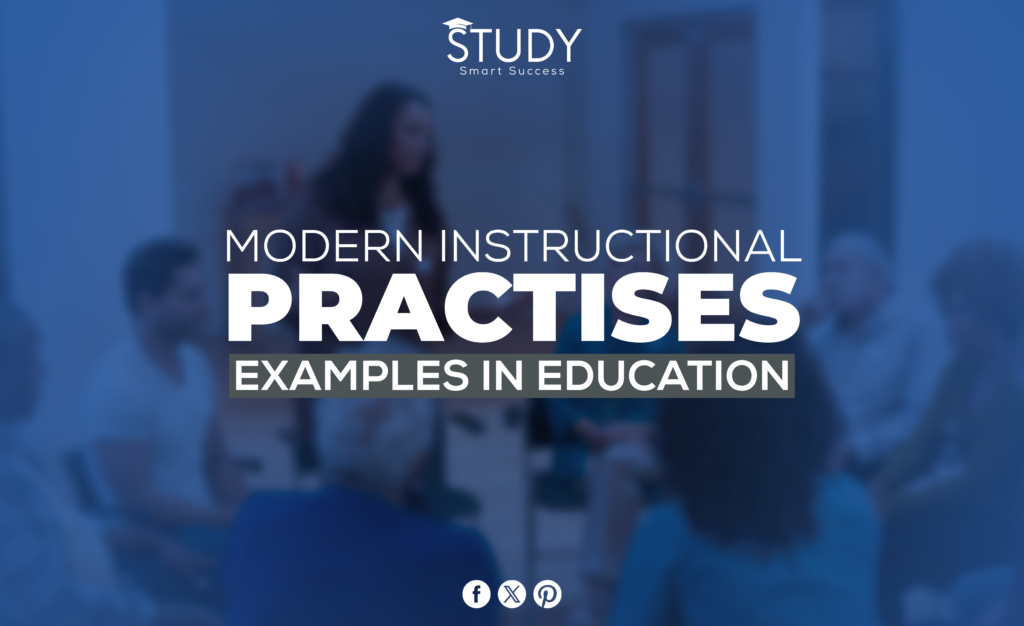The world of education is constantly changing, so the best ways to teach need to change, too. These days, learning isn’t just about memorizing facts. It’s about giving students the tools to succeed in a complicated world. Teachers, instructional designers, and school officials must understand and use modern teaching methods to create a lively learning environment. This complete guide shows you the best ways to teach using examples from real life that you can use to make learning better for your kids.
To read more about behavior management in the classroom, you must visit this link.
Understanding Modern Instructional Practices
The techniques and methods teachers use to help students learn are called instructional practices. Students come first in modern teaching methods, which include using technology and focusing on how to use what you’ve learned to solve problems in the real world.
These activities aim to get students to learn by doing and promote critical thought, innovation, and teamwork. Instead of standard lecture-based methods, teachers can create a space that helps students grow in all areas and understand things better.
The Student-Centered Approach
The students are at the centre of student-centred teaching, where they are the ones who learn. Each student’s unique learning needs and hobbies are emphasized, giving them more control and freedom. Project-based learning (PBL) is an example of a strategy that puts the student at the centre.
In PBL, students look into and answer complex questions or problems, which usually lead to a physical product or show. For example, as part of a sustainable project, students in a classroom might study, plan, and carry out a program to reduce waste at school. In this way, they learn about environmental science and social duty in a real-life setting.
Technology Integration
As technology has become an essential part of modern life, it should also be an important part of the school. Using digital tools and resources to improve learning is what technology integration means. The split classroom approach is one example. In this method, students use online tools to learn material outside class.
This makes class time available for active, hands-on learning. Students in a history class might be told to watch a lesson about the Industrial Revolution at home. During class, the teacher might then hold a Socratic discussion on the subject to get students to think more deeply about it.
Real-World Application
The idea behind modern education is that people learn best using what they’ve learned in real life. By using real-life situations and problems, teachers can show how their teaching methods are useful in the real world.
Case studies are an excellent example of this because they let students look at real-life events and figure out how to apply academic ideas. In business class, a case study about a successful new business can teach students about how to sell, handle money, and become an entrepreneur.
Collaborative Learning Environments
Students are encouraged to work with others in collaborative learning settings to finish projects, solve problems, or talk about different themes. This method not only helps people get along better with each other, but it also helps people understand things better by having them teach each other.
This is when teachers don’t just give out information; they also help students learn. In a science class, students might work together to plan and carry out projects about green energy, which is an example of joint learning. Students learn to value different points of view, work out their differences, and build on each other’s ideas by working together. These are all skills necessary for the workplace in the 21st century.
The Core Components of Modern Instructional Practices
Modern teaching methods cover a lot of ground, but a few key things make them work. If teachers understand these parts, they can plan and use their lesson plans more carefully.
Learner Engagement
Engaging students is the key to good teaching; interested students are driven to learn. Teachers can get students more interested in learning by engaging in lessons, group teamwork, and game-based learning. In a language class, for example, students could use an app that makes them compete with each other to learn new words. This would make what could be a tedious job more fun and exciting.
Active Learning
Instead of simply getting knowledge, active learning requires students to participate in the process by discussing, fixing problems, and analyzing. Think-pair-share activities are one way to get students to learn actively.
In these activities, students think about a question or idea, talk about it with a partner, and finally share what they’ve learned with the class. This method could be used to discuss a new scientific find in a science class, allowing students to explain and improve their knowledge through conversation.
Differentiation
Teachers need to be aware of and adapt to their students’ different learning styles and needs. Differentiating teaching means changing the process, result, or material to fit each student’s ability level, interest, and learning style. A high school math teacher might use tiered lessons to show the same basic ideas at different difficulty levels to students who already know much about math and are good at school.
Continuous Feedback
Giving kids comments all the time is an important part of making sure they feel valued and understood in the classroom. This feedback process between the teacher and the student clears up any confusion immediately and motivates the students to try new things and take chances.
For instance, teachers can quickly review student work and give fast, personalized comments using digital platforms. This process helps students learn and creates a safe space in the classroom where they can try new things and ask questions.
Implementing Modern Instructional Practices for Success
Adopting current ways of teaching is not something that can be done in one way. Teachers need to think about the specifics and limits of their workplace locations. Here are some steps you can take to use current ways of teaching properly.
Professional Development
Teachers should look for chances for ongoing professional development to keep up with the newest tools and ways to teach. Workshops, gatherings, and online courses can all help teachers improve their methods by giving them useful information and training.
Curriculum Design
It is essential that current methods and program planning work together. Planners should ensure that the teaching methods support the learning goals and that tests measure the results they want to see. This ensures that the lessons focus on the students and have real-world applications.
Cultivate a Supportive Learning Community
Schools should create a helpful learning community where teachers can work together, share the best ways to do things, and get help. For example, regular staff meetings can be used to discuss how to teach and build a network of people who can help each other.
Technology Integration
The use of technology in the classroom is an integral part of current teaching methods. Technology provides many valuable tools that can significantly improve the learning process by making it more engaging and open to more people. For example, virtual reality (VR) can mimic real-life situations, which makes learning about old cultures or current science very interesting for students.
In the same way, online tools can help students worldwide work together on projects, increasing global understanding and digital skills. Teachers can use these tools to make the classroom more exciting and help students get ready for a world that is based.
Assessment for Learning
Formative evaluation, also known as testing for learning, is another important part of current teaching methods. Formative exams are used throughout the learning process, unlike standard tests that check students’ understanding at the end of a learning period.
This method gives teachers and students instant input, which lets them change their teaching and learning methods in real-time. For instance, teachers could use quizzes sent through an educational app to see how much students understand during a lesson. This would allow for quick changes that help students learn.
Using these modern teaching methods requires careful planning and dedication to put the student at the centre of the learning process. By using these techniques, teachers can make a learning space that teaches and encourages students to think critically, be creative, and keep learning throughout their lives.
Real-World Success Stories in Modern Instruction
Understanding how current teaching methods work helps one look at examples of success in the real world.
Charlotte’s Technology-Infused Middle School Math Program
In Charlotte, a middle school math program that used technology instead of texts gave students their digital material. Adaptive learning technology lets each student move at their own pace, and real-time data tells teachers about each student’s success so they can give them specific help. Students across the area got a lot better at math because of the program, which got them more involved.
The Success of the Student-Centered Program in San Francisco
Students in a student-centred school in San Francisco worked on many different projects, like community service, urban planning, and studying the environment. When these projects were added to the curriculum, they gave students a deeper, more valuable learning experience that was more useful to their lives.
Incorporating Global Perspectives through Virtual Exchanges
One more inspired example comes from a high school in New Jersey that used virtual exchange programs to start a global learning project. Students from various countries worked together on projects addressing issues like climate change, poverty, and unfairness that affect people worldwide.
This one-on-one contact helped students learn more about world problems, become more culturally aware, and improve their communication and teamwork skills. The project not only made students more aware of issues happening worldwide but also enhanced their ability to think critically and solve problems by getting them to consider how to solve these complicated problems.
This program’s success shows how technology can break down the walls of the standard classroom and give students access to a broader range of ideas and experiences.
The Road Ahead for Instructional Innovation
Adopting new ways of teaching is a constant process that needs everyone to be committed, have an open mind, and support it. Teachers who try to use these methods are not only preparing their students for the difficulties they will face in the future but also making the education system more active and valuable.
Conclusion
In conclusion, the examples of current teaching methods are just the start. Teachers can make a place where students think critically, develop new ideas, and love learning for a lifetime by using these techniques and always looking for new ways to keep students interested. These habits have effects that go beyond the school setting and change how students deal with problems and chances in the real world.
It looks like the future of education will be better than ever if we keep using new teaching methods. Let’s keep coming up with new ideas, working together, and helping each other as we try to make an education system that trains kids for success in a world that is constantly changing.



